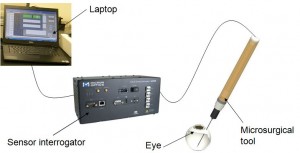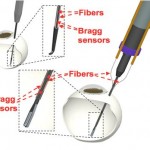Feb
14
2012
In May of 2011, I blogged about a fiber-optic-based rock deformation measurement system at the Sanford Underground Research Facility (SURF) (formerly the Sanford Underground Science and Engineering Laboratory (SUSEL)). www.sanfordundergroundlaboratoryathomestake.org .
SURF is an interim facility under construction while DUSEL funding is pending from the DOE. Last week, Fermilab www.fnal.gov hosted a DuRa meeting attended by physicists and scientists from all over the world. This meeting was held to update the community on the progress of the current and future experiments at SURF.
During the meeting members of DuRa viewed a live feed of an experiment at the 4100ft level of the Homestake Mine in Lead, SD. This experiment involved loading the rock mass with a 100 ton capacity jack. More than 30 FBG based strain gages recorded the rock deformation during loading.
Both “strain strips” (a clever embedded strain measurement transducer created by the GEOXTM Team) and Micron Optics os3600 long gage strain sensors, embedded and mounted on the surface, successfully measured changes in the rock as small as a few microns.
This system has been live 24\7 for nearly three years. Stay tuned as I will post the new data as it becomes available.
To view the pre-recorded “live” feed follow this link : http://vmsstreamer1.fnal.gov/VMS_Site_02/Lectures/DURA/120119Roggenthen/index.htm
Note this link best viewed with Firefox or Safari as some viewers had issues with viewing in IE.
You can also view some quick data plots from the experiment.
Alan Turner
Sep
30
2011
There are many reasons that engineers and scientists select Fiber Bragg Grating (FBG) sensors for their applications. Here’s a case where the FBG’s small size and need for ultra-high sensitivity were the drivers.
Researchers at Johns Hopkins University are working to help surgeons find tools to make delicate eye surgery more safe and effective. Employing robots in these procedures would help translate relatively coarse human motion into much more stable, controlled and fine machine motion. But to make this feasible, the surgeon must have tactile feedback, that is, a sense of touch that would be translated back through the mechanism.

So this is where the FBG sensors play a key role. FBGs are embedded in to a 0.5mm (25 gauge) diameter instrument so that when it contacts a delicate membrane in the eye, the surgeon would feel the direction and magnitude of the contact. The Micron Optics sm130-700, sampling at 2kHz, measures the FBG’s and is integrated into the feedback and control loop.
 Images courtesy of Russ Taylor/Iulian Iordachita
Images courtesy of Russ Taylor/Iulian Iordachita
This work is detailed nicely in this paper “A sub-millimetric, 0.25 mN resolution fully integrated fiber-optic force-sensing tool for retinal microsurgery“. You can also find information at the website of the JHU Laboratory for Computational Sensing + Robotics and at the CISST website (scroll down and click on Article on Russ Taylor and surgical robotics).
For more information, contact Iulian Iordachita at iordachita@jhu.edu
Sep
01
2011
Atlanta, GA (September 1, 2011) Micron Optics, Inc. is proud to announce the sm690, a new ultra-high speed, high resolution data acquisition module capable of simultaneously measuring up to four Fiber Bragg Gratings (FBGs) at a 2MHz sampling frequency, a rate which is currently unparalleled in the optical sensing industry.
Go to www.micronoptics.com to see the full press release
Jun
29
2011
Micron Optics announced the installation of one of their state of the art optical interrogation systems on one of the nation’s most famous monuments, Mount Rushmore. The Rock Block Monitoring System (RBMS) will provide the National Park Service with critical information about shifts in the rock system which makes up the Mount Rushmore National Monument. The RBMS was installed in partnership with Respec Inc. and the Mount Rushmore Rope Access Team and is composed of one Micron Optics sm125 Optical Sensing Interrogator and 36 sensors.
For more information, see the full press release or read the case study on the website.

